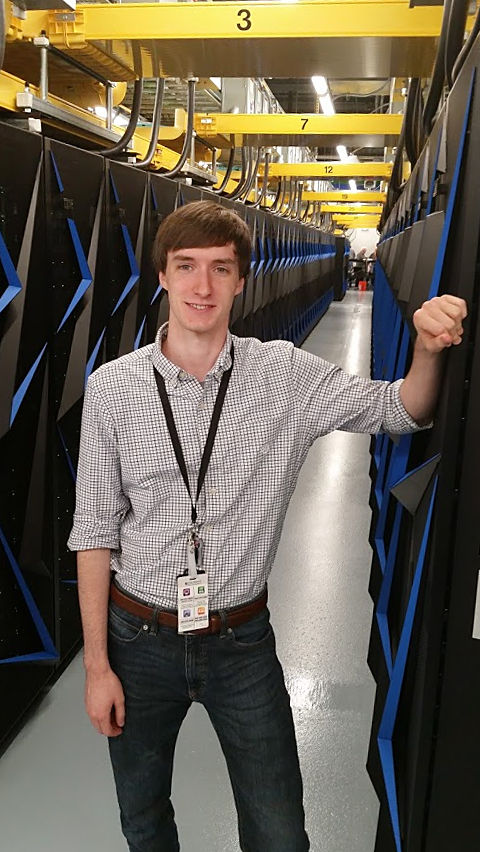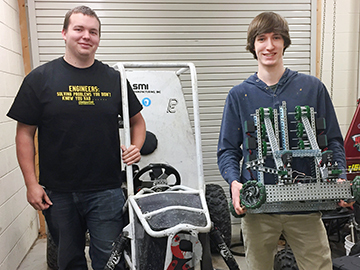Success Story: Grad’s COVID-19 research team wins supercomputing prize
Alex Brace First Learned Teamwork In NMC Engineering Club
March 3, 2021
 An alumnus who is part of a team that recently won a special prize for high performance computing-based COVID-19 research credits NMC for turning him on to science and mathematics in the first place.
An alumnus who is part of a team that recently won a special prize for high performance computing-based COVID-19 research credits NMC for turning him on to science and mathematics in the first place.
Armed with an associate degree and an engineering certificate, Alex Brace left NMC in 2017 for an internship at the Department of Energy’s Oak Ridge National Laboratory in Tennessee. Historically known as the home of the Manhattan Project, Oak Ridge was about to claim another scientific distinction: home of the fastest supercomputer in the world. Summit debuted at Oak Ridge in 2018, and Brace (right), who had been the Engineering Club president at NMC and started a robotics club that practiced in campus hallways, would soon get to use it.
Last year, Brace was part of a team of researchers nationwide who again turned to Summit to win the Gordon Bell Special Prize for outstanding research achievement towards the understanding of the COVID-19 pandemic through the use of high-performance computing. As he now awaits a decision on his Ph.D. applications, Brace, 25, credits instructors like Mary Jo Elliott in chemistry, and retired math instructors Mary Burget and Jack Berman for directing him toward a STEM career. (Check out options including a new engineering associate degree.)
“I really started with no technical experience,” said the 2014 Traverse City West High School graduate, who took a year off between graduation and enrolling at NMC. “NMC really brought me up from algebra into calculus and beyond.”
It was Elliott who suggested he apply for the Oak Ridge internship, in fact. (She’s since recommended other students to DoE labs — read about another here.)
“The professors really knew how to expose students to opportunities,” Brace said, something he missed when he transferred to the University of Michigan to study computer science in the fall of 2017.
“It’s a big pool,” he said of the Ann Arbor campus. “You didn’t have the community support and the faculty to prop you up and notice if you’re struggling.”
Brace completed a second internship at Oak Ridge in 2018, and graduated from U-M in 2020, just as COVID hit. He then moved on to a predoctoral research associate position with DoE’s Argonne Lab in suburban Chicago, where his Oak Ridge mentors had moved. Due to the pandemic, his work has been all virtual, yet it still led his team to claim the special prize. Brace says he first learned that kind of teamwork at NMC.
 NMC Engineering Club members Caleb Vieracker (left) and Alex Brace pose with projects in 2017“With the Engineering Club, it was all about the team effort. It’s the same thing in big science. It’s just the scale has gone off to infinity,” he said.
NMC Engineering Club members Caleb Vieracker (left) and Alex Brace pose with projects in 2017“With the Engineering Club, it was all about the team effort. It’s the same thing in big science. It’s just the scale has gone off to infinity,” he said.
Considered the Nobel Prize of supercomputing, the team was recognized for the wide-reaching, nationwide collaboration to develop unprecedented simulations of key aspects of the coronavirus. The simulations provide an atomic-level view of how the virus works.
“We are giving people never-before-seen, intimate views of this virus,” said Rommie Amaro, project co-leader and a professor at the University of California San Diego. “Why we care about this is because if we want to understand how the virus infects the host cell, if we want to be able to design antibodies and new drugs to block and cure infection, if we want to be able to design new therapeutics, this information at this very fine resolution at the atomic level is required.”
Summit has now dropped to the second-fastest computer in the world, behind one in Japan, but one that’s faster still is slated to come online in the U.S. in 2022, Brace said. As he stands on the cusp of his career, he’s fascinated by all the discoveries that lie ahead in artificial intelligence, mathematical modeling, and exascale computing.
“That’s the next generation of computing. This is just a taste of what’s to come,” Brace said. “We’re really pushing the boundaries of what’s possible.”
How fast is the Summit supercomputer?
- Summit can solve a problem in one hour that would take 30 years on a desktop.
- If every person on Earth did one calculation per second, it would still take 305 days —10 months — for the collective world population of 7.5 billion to do what Summit can do in one second.
Want more stories like this?
NMC students past and present are achieving success in the classroom and in their careers. This section showcases just a few examples.
Sign up for NMC Now to get these stories, plus upcoming campus events and media mentions, delivered to your inbox every other Wednesday. View past issues here »